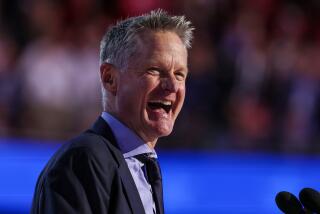Return of Kerr Sparks Arizona to No. 1 Spot
- Share via
TUCSON — Not coincidentally, the basketball fortunes of first-time-ever No. 1 Arizona have soared this season with the return to action of point guard Steve Kerr.
Coach Lute Olson thinks Kerr “is the best point guard in the country.” Not bad for a kid nobody wanted five years ago.
Not bad for someone who so badly tore knee ligaments 16 months ago in the World Championships games in Madrid, Spain that one doctor immediately called it career-ending.
But right in step for someone who has faced down obscurity, drama and adversity and whose winning personality and boy-next-door looks have made him the object of a citywide love affair.
Kerr had but one other scholarship offer, from Gonzaga University. Most schools considered him too slow.
He and Olson both joke about his speed, and Kerr insists he’s the only 6-3 guard in the country unable to dunk.
But Olson said getting the sharp-shooting Kerr prior to the start of 1983-84 season, their first at Arizona, was basically a fluke that wouldn’t happen today.
“With our recruiting now, most of our signees are early signees, and Steve was so late that he couldn’t even sign--it was beyond the letter-of-intent date,” Olson said last week. “So we probably would have filled our quota prior to the time that he would have surfaced.”
He also said Kerr was an unknown entity to the scouting services, and that he went on a tip to see Kerr in a Los Angeles summer league in 1983 “because we had to have a shooter.”
During his freshman year, Kerr came off the bench to hit five of seven field goals and score 15 points against arch-rival Arizona State only a few days after his father, Malcolm Kerr, was killed as president of American University in Beirut, Lebanon. Fans at McKale Center began a tradition that continues, echoing the announcer’s “Ste-eeve Kerrrrrrr!” after every basket he scores.
He moved to point guard in 1985-86 and led Arizona to its first Pac-10 championship, earning all-conference recognition.
After his reconstructive knee surgery, Kerr went through a lengthy rehabilitation and brought himself along slowly for the first few games this season, easing into his game.
He and Olson insist he’s quicker now than before the injury.
Kerr was, and remains, a shooter, though until two weeks ago, he thought he had been playing a little tentatively. “I need to get out there and get some shots off,” he said then.
He did, and through the Wildcats’ first nine wins this year was shooting at a .626 clip with an 11.8-point average, hitting 36 of 57 two-pointers (.632) and 26 of 42 three-point tries (.619). He had hit 8 of 12 free throws, had 38 assists, two rebounds a game, eight steals and 10 turnovers in 29 minutes per game.
In a 66-59 win at then third-ranked Iowa, he played 40 minutes against a pressing defense without turning the ball over.
Olson credits Kerr’s leadership abilities--his heady play and steadying influence--for the team’s success, including other impressive wins over highly ranked Syracuse and Michigan last month.
Last Sunday, the Wildcats, prohibitive Pac-10 favorites, began league play with a 110-71 rout of Washington at Seattle.
“I thought we’d be a good team, but we wouldn’t be as good a team as we are” without Kerr, said Olson. “There’s no question we would not be undefeated, we could not have won at Iowa without him and I’m sure we couldn’t have beaten Syracuse without him.”
Olson said Kerr and Ronnie Lester, who led his 1980 Iowa team to the NCAA Final Four, are the best guards he has coached. But he said they are “so different that I don’t think you could really compare ‘em. Lester was a jet, not nearly as strong a leader as Steve but so much more athletic. Both of ‘em were really good players for their team.”
Lester went on to become the fourth player selected in the NBA draft and would have gone higher if not for a knee injury, Olson said.
More to Read
Go beyond the scoreboard
Get the latest on L.A.'s teams in the daily Sports Report newsletter.
You may occasionally receive promotional content from the Los Angeles Times.










